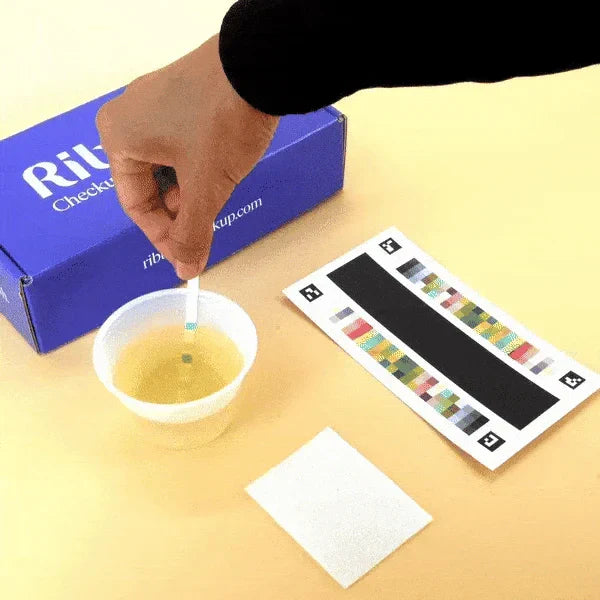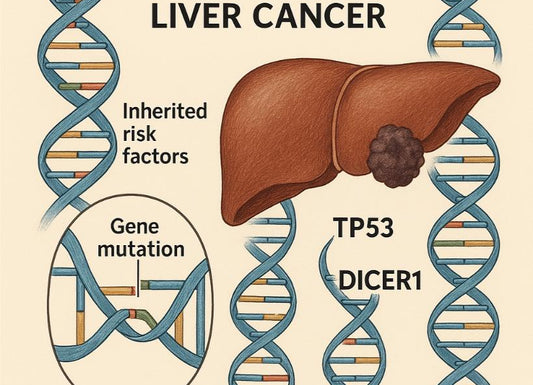How the Ribbon Checkup Test Works—And Why It’s Changing At-Home Health Monitoring
 Written By
Blen Shumiye, MD
Written By
Blen Shumiye, MD

If you're trying to stay on top of your health or manage a chronic condition like diabetes or high blood pressure, it’s helpful to have tools that offer real insight. The Ribbon Checkup Test was designed with that exact goal: giving you the power to assess your internal health without a clinic or lab.
This guide explains how the Ribbon Checkup Test works, what it can tell you, and how to use it confidently and correctly. Whether you're monitoring your kidney function, watching for early signs of dehydration, or just curious about your wellness baseline, here's what you need to know.
What Is the Ribbon Checkup, Exactly?

The Ribbon Checkup is a lab-grade, at-home urine test that analyzes up to 10 different health markers using a simple dipstick and an AI-powered smartphone app. It’s designed to be easy enough for anyone to use, while still offering medical-grade insights.
After dipping a test strip in your urine sample, you place it on a special Color Card and scan it with your smartphone or desktop webcam. The system analyzes the color changes on the strip and gives you instant feedback about what's happening inside your body.
This isn’t just about convenience. It's about access to reliable, meaningful health information without having to wait days for results or schedule a doctor’s visit. Ribbon helps you get answers in real time, especially if you're tracking symptoms like frequent urination, fatigue, bloating, or unexplained weight changes.
What Can Ribbon Checkup Help You Monitor?
Ribbon measures 10 common markers in your urine that can indicate early signs of metabolic, kidney, urinary, or liver stress. These include:
-
Glucose (sugar)
-
Protein
-
Blood
-
Leukocytes (white blood cells)
-
Nitrites (bacteria)
-
Ketones
-
Bilirubin
-
Urobilinogen
-
pH level
-
Specific gravity (hydration)
Each of these markers can offer a clue about your health. For example, detecting elevated glucose (sugar) in urine indicates diabetes or other metabolic disorders, which is very helpful for a diabetic patient. Nitrites and leukocytes in urine indicate a UTI. Not only this, the Ribbon kit also helps you track your liver health by monitoring your urobilinogen and bilirubin. With these markers and the AI app, Ribbon Checkup gives you more comprehensive information.
Who Should Consider Using This Test?
Ribbon is helpful for a wide range of people, including those:
-
Managing diabetes or prediabetes
-
Recovering from COVID-19 or another illness that affects the kidneys
-
With a history of urinary tract infections or kidney stones
-
Living with high blood pressure or heart disease
-
Following low-carb or keto diets
-
Curious about their hydration status or liver health
If you've ever left a doctor’s office feeling unsure about what’s going on or wished you could follow up without another appointment, Ribbon Checkup gives you that option.
You don’t need to be sick to benefit from testing. Many people use Ribbon as part of their overall wellness routine to catch small changes before they become bigger problems.
How Does the Test Work, Step by Step?
The testing process is simple and takes just a few minutes. Here's how it works:
Step 1: Collect your urine sample
Use the sterile cup provided in your kit. A first-morning urine sample is ideal, as it’s more concentrated and accurate for testing.
Step 2: Dip the test strip
Submerge the strip in your sample for two seconds, then place it on the Color Card. This card helps the AI detect color changes more precisely across different lighting conditions.
Step 3: Wait 60 seconds
Allow time for the chemical pads on the strip to react. Each square will start to change color depending on what's present in your urine.
Step 4: Scan with your phone
Open the Ribbon Checkup app or web browser, align your phone with the strip, and capture a scan. The app uses AI to analyze the strip, compare it to medical standards, and return results instantly.
Step 5: View and interpret your results
You’ll see a full panel report with insights on each marker. The app helps you understand what’s within range, what’s borderline, and what may need attention.
How Accurate Is the Ribbon Checkup Test?
Accuracy is one of the most common concerns with any at-home test—and rightly so. Ribbon uses the same medical-grade test strips found in clinics, plus a calibrated Color Card and AI-powered analysis to reduce errors.
Unlike standard dipstick tests, which rely on human vision and color interpretation, Ribbon removes guesswork. Even subtle color differences are analyzed precisely, creating consistent, clinically relevant results.
The system is validated against professional lab equipment, and results for many markers align within clinically accepted ranges. That said, any abnormal reading should be shared with a healthcare provider. Ribbon isn’t a diagnosis—it’s a tool for awareness and action.
What Happens If Your Results Are Abnormal?

If one or more markers are flagged as abnormal, take a breath. Ribbon's goal is to help you detect changes early, before symptoms worsen or complications arise.
Here’s what to do:
-
Review the guidance provided: The app will explain what an abnormal result might mean and whether retesting is recommended.
-
Repeat the test: If results are borderline or you’ve eaten something unusual, test again the next morning for confirmation.
-
Stay hydrated: Many abnormalities—especially elevated specific gravity or ketones—can be linked to dehydration.
-
Follow up with a doctor: If results consistently show signs of blood, protein, or infection markers, seek medical guidance. Ribbon offers downloadable reports you can share with your provider.
Many Ribbon users have used their results to start meaningful conversations with their doctors—conversations that might have otherwise been delayed.
What Conditions Can Ribbon Checkup Help You Track?
Ribbon is not a diagnostic tool, but it can support early detection or ongoing monitoring of:
-
Kidney damage (especially in people with diabetes or hypertension)
-
UTIs and bladder infections (common among women and older adults)
-
Dehydration (especially in athletes, outdoor workers, or those with low fluid intake)
-
Liver dysfunction (bilirubin and urobilinogen levels may reflect early liver stress)
-
Metabolic changes (including ketone buildup during fasting or ketosis)
-
Glucose spikes (for those monitoring diabetes or insulin resistance)
These markers often change before symptoms appear, giving you a valuable head start in managing your health.
Can Ribbon Checkup Replace Your Doctor?
Ribbon Checkup is meant to complement—not replace—your regular medical care. It helps you understand what’s going on between doctor visits and empowers you to track how lifestyle changes are impacting your body.
For example, a diabetic patient can track their condition using Ribbon kit markers. If there is glucose in the urine, it indicates high blood sugar levels (above 180), and if there are urine ketones, it may indicate diabetic ketoacidosis (DKA).
How Often Should You Use Ribbon Checkup?
How often you test depends on your goals. Here are a few common rhythms:
-
Monthly: General wellness and early detection
-
Weekly: Managing a condition or tracking a new diet or medication
-
Daily: For short-term monitoring after illness, infection, or surgery
It’s best to test at the same time of day each time. Morning is preferred for consistency and clarity. And always ensure you’re using a clean container and strip to avoid contamination.
What Does the Ribbon App Include?

The Ribbon app (available on iOS, Android, and desktop) is more than just a scanner. It includes:
-
Easy test instructions
-
Instant results and interpretation
-
Tracking over time (spotting trends)
-
Report downloads for providers
-
Reminders for re-testing
The app is free to use during your trial period, then offers a subscription for $19/month, which includes unlimited scanning and data storage.
This subscription also helps fund continued clinical development and ensures the AI analysis remains accurate as new phones and lighting conditions evolve.
What Do Real Users Say About Ribbon?
Ribbon Checkup has thousands of users who’ve reported that the test has helped them:
-
Detect early UTIs before symptoms worsened
-
Track blood and protein levels post-COVID
-
Adjust hydration after seeing specific gravity spikes
-
Gain peace of mind while managing diabetes
-
Identify possible kidney concerns that led to earlier diagnosis
The most common feedback? “It helped me feel in control of my health.”
People also appreciate the calm, easy-to-understand design of the app. No scary charts, no confusing terminology—just clear answers in plain language.
What’s the Bottom Line?
If you’re looking for a reliable, medically informed way to track your health at home, the Ribbon Checkup Test is a strong option. It blends the power of professional-grade testing with the ease of smartphone technology.
Whether you’re managing a condition, curious about your hydration status, or just want to be more proactive, Ribbon makes it simple to check in with your body.
At a time when health feels more complex than ever, it’s a small step that can make a big difference.

Dr. Blen is a seasoned medical writer and General Practitioner with over five years of clinical experience. She blends deep medical expertise with a gift for clear, compassionate communication to create evidence-based content that informs and empowers. Her work spans clinical research, patient education, and health journalism, establishing her as a trusted voice in both professional and public health spheres.



